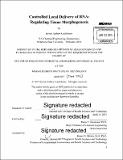| dc.contributor.advisor | Paula T. Hammond. | en_US |
| dc.contributor.author | Castleberry, Steven Andrew | en_US |
| dc.contributor.other | Harvard--MIT Program in Health Sciences and Technology. | en_US |
| dc.date.accessioned | 2015-09-17T19:07:37Z | |
| dc.date.available | 2015-09-17T19:07:37Z | |
| dc.date.copyright | 2015 | en_US |
| dc.date.issued | 2015 | en_US |
| dc.identifier.uri | http://hdl.handle.net/1721.1/98724 | |
| dc.description | Thesis: Ph. D., Harvard-MIT Program in Health Sciences and Technology, 2015. | en_US |
| dc.description | Page 283 blank. Cataloged from PDF version of thesis. | en_US |
| dc.description | Includes bibliographical references. | en_US |
| dc.description.abstract | RNA interference (RNAi) is a powerful technology that provides a means to alter the expression of a specific protein based on a targeted RNA sequence. This is done by taking advantage of existing cellular machinery present within all eukaryotic cells which use short double-stranded RNA sequences as guides for RNA induced silencing. The potential for RNAi in medicine is enormous, providing a new approach to treat the complex biological dysregulation underlying many diseases. This promise of a new branch of therapeutics however has been mired with difficulties. RNA is quickly degraded by nucleases that are prevalent in the blood and throughout the body, it is highly immunogenic, and systemic delivery is complicated by high clearance rates. As such, developing formulations for the effective delivery of short RNAs presents significant hurdles. Local delivery can limit numerous unwanted systemic side effects of therapies and it maintains the highest therapeutic index possible in a targeted area before clearance. As such, the local delivery of siRNA may hold just as much potential as systemic delivery with significantly reduced complications. Layer-by-layer (LbL) assembly is a robust method that has been successfully demonstrated for the localized and sustained delivery of many biologic therapeutics and biomolecules. Developing an LbL film capable of delivering siRNA locally would offer a powerful new approach to the treatment of local disorders. This approach could be combined with existing medical devices to improve patient outcomes by directly addressing pathologic dysregulation in the area of interest. One field where the local treatment of dysregulation could be of particular interest is that of wound healing. Wound healing is a complex and highly synchronized process of multiple biological pathways, consisting of an assortment of cytokines, growth factors, and varied cell types which evolves over time. The development of a drug delivery system that can locally modify cell behavior on the basic level of gene transcription would be a powerful tool to alter the dynamics of wound healing. There are many known complications of wound healing, ranging from chronic ulcerative wounds to hypertrophic contractile scars, which dramatically affect the lives of tens of millions of patients every year. Through RNA interference, one could specifically target the key mediators of these complications, providing a means to more effectively regulate the wound healing process in vivo. The capability to deliver siRNA locally to address these complications is a significant advance in the current state of wound treatment. As such, this work presents an opportunity to substantially improve the current standard of treatment for patients and their wound healing outcomes. Herein, we present the design and preclinical evaluation of a number of strategies to develop ultra-thin polymer coatings for the controlled delivery of RNA both in vitro and in vivo. We used Layer-by-Layer assembly to create siRNA containing polymer-based films that can sustain the release of complexed siRNA over physiologically relevant timescales for local delivery into tissues. We describe the development of the first high-throughput approach for LbL assembly and screening and its use to identify lead candidate film architectures for RNA delivery. We then apply these findings to treat dysregulation in two distinct animal models; a chronic diabetic mouse wound model and a third-degree bum model in rats, targeting three different genes of interest independently. These coatings were demonstrated to effectively coat a number of medically relevant substrates including bandages, sutures, surgical staples, nanoparticles, microparticles, and microneedles. This body of work provides insight into how siRNA can be incorporated into thin film assemblies and the design criteria to achieve successful gene knockdown in vitro and in vivo. | en_US |
| dc.description.statementofresponsibility | by Steven Andrew Castleberry. | en_US |
| dc.format.extent | 283 pages | en_US |
| dc.language.iso | eng | en_US |
| dc.publisher | Massachusetts Institute of Technology | en_US |
| dc.rights | M.I.T. theses are protected by copyright. They may be viewed from this source for any purpose, but reproduction or distribution in any format is prohibited without written permission. See provided URL for inquiries about permission. | en_US |
| dc.rights.uri | http://dspace.mit.edu/handle/1721.1/7582 | en_US |
| dc.subject | Harvard--MIT Program in Health Sciences and Technology. | en_US |
| dc.title | Controlled local delivery of RNA : regulating tissue morphogenesis | en_US |
| dc.title.alternative | Controlled local delivery of ribonucleic acid : regulating tissue morphogenesis | en_US |
| dc.type | Thesis | en_US |
| dc.description.degree | Ph. D. | en_US |
| dc.contributor.department | Harvard University--MIT Division of Health Sciences and Technology | |
| dc.identifier.oclc | 920872631 | en_US |
